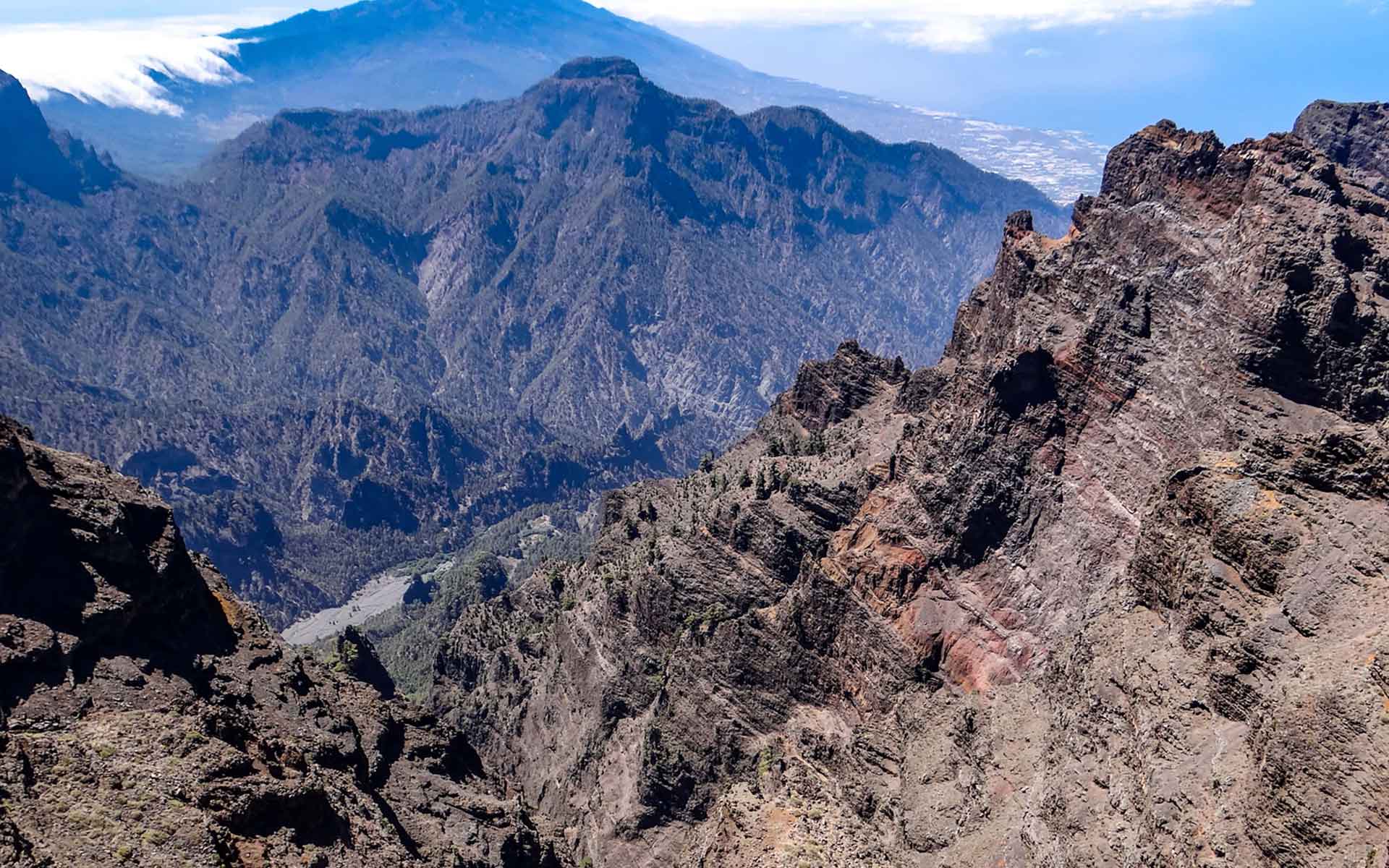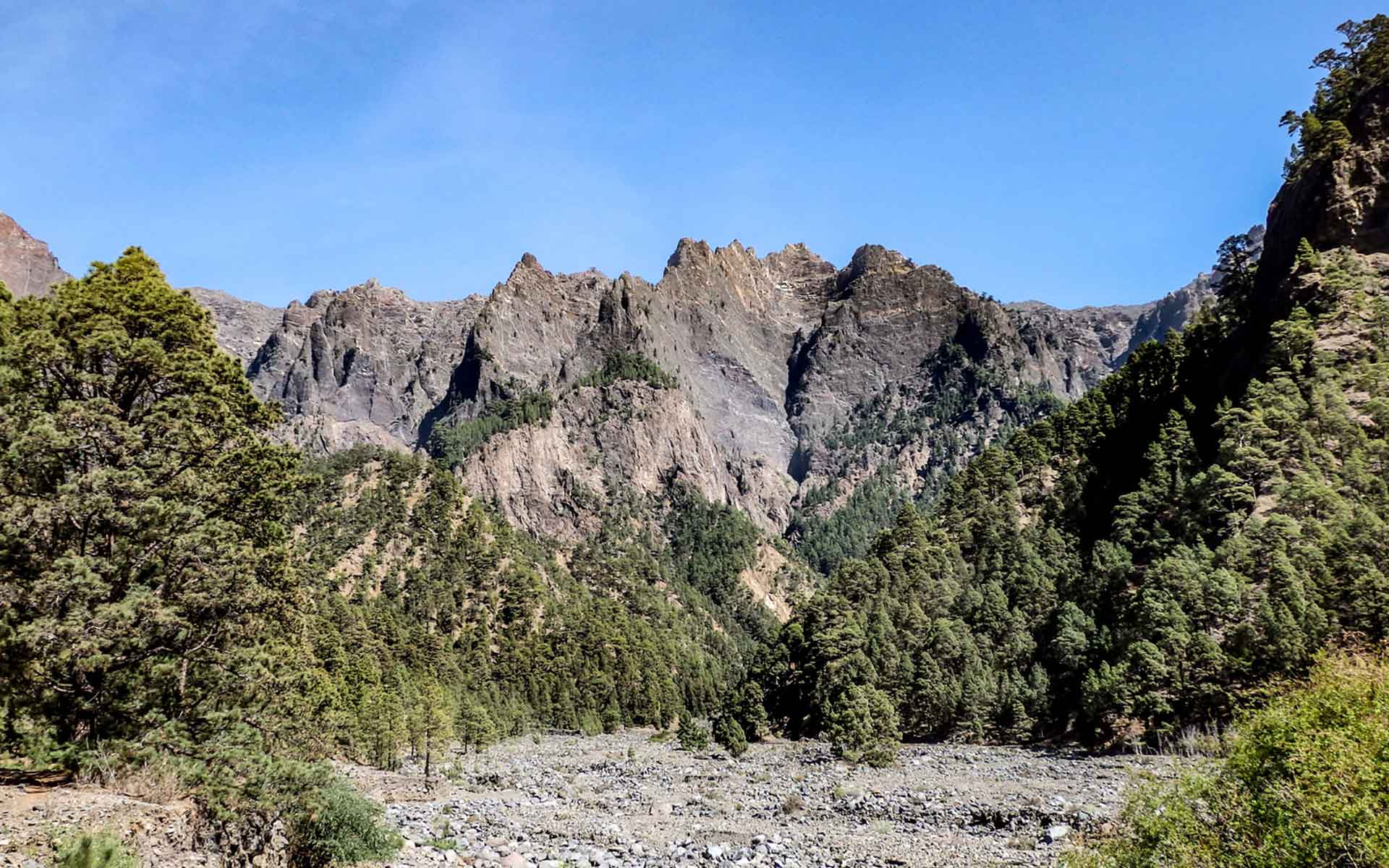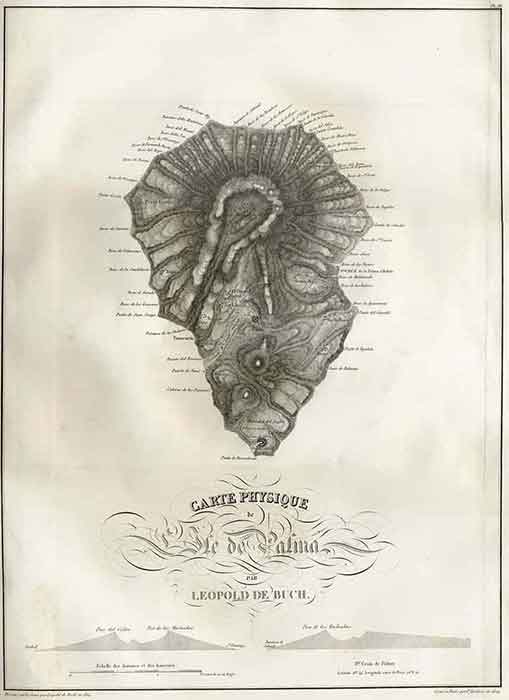
Caldera de Taburiente seen from the crater top to the South of La Palma Island.
Geological Period
Pliocene – Quaternary
Main geological interest
History of geosciences
Volcanology
Location
La Palma Island Canary Islands, Spain.
28°44’00.8″N, 17°52’13.5″W
Caldera de Taburiente seen from the crater top to the South of La Palma Island.
The volcanic landform known worldwide as caldera was named after the first use of this local term in this site in the beginning of the 19th century.
Taburiente Caldera contributes to the development of volcanology since the 19th century, not only for the contribution to the ‘Theory of elevation craters’ (von Buch, 1825) but also for being the most complete record of the evolution of an oceanic volcanic island. In this Caldera has been possible to study the Pliocene submarine basal complex, the metamorphism originated by the magmatic intrusion, the building of a Quaternary volcanic edifice, and giant landslides and intense erosion that defines its final morphology (Lyell, 1865; Gagel, 1908; Hausen, 1969; de la Nuez, 1983; Staudigel and Schmincke, 1984; Carracedo et al., 2001).
Caldera de Taburiente seen from inside the crater to the North wall. This big circular and deep volcanic morphology of La Palma Island served as a model for volcanic craters that are called ‘Caldera’. This local name is used in Geology since the 19th century by geologist who studied Taburiente and ‘caldera’ is used worldwide as a volcanic term.
- Geological description
This large volcanic structure that forms a crater 8 km in diameter and more than 2000 m deep has been the model for defining large volcanic craters from the local name of ‘Caldera’. This local term, which comes from the aborigines of the island, is used to define this circular volcanic morphology of large diameter, almost vertical inner walls, which stands out and its great depth.
Nowadays, Taburiente is one of the best examples of a deep erosive volcanic caldera that records great erosive processes that predominate in an oceanic volcanic environment. Giant landslides and the deep fluvial incision of the Las Angustias gorge has connected the Caldera with the Atlantic Ocean throughout the Late Pleistocene and Holocene (Carracedo et al., 2001). Precisely because of these intense erosional and tectonic processes, it is possible to observe the interior of the island from the early submarine stages of Pliocene age and the intense magmatic and dyke intrusion triggered metamorphic processes in the primitive seamount, which uplifted it up to 1500 m asl (de la Nuez, 1983 Staudigel and Schmincke, 1984). The subaerial volcanic reactivation continued during the initial stages and Pleistocene volcanic activity was dominated by superimposed volcanoes.
- Scientific research and tradition
Taburiente Caldera is linked to renowned naturalists of the nineteenth and twentieth century worldwide. L. von Buch (1825) traveled to the Canary Islands on the express recommendation of A. von Humboldt. But it was Lyell and Hartung, who make specific reference to the Spanish term “caldera” in Taburiente to refer to this great volcanic morphology. During the 20th century, scientific expeditions continued with the researchers as Gagel, Jeremine, Middlemost, Schmincke, Staudigel, Hernández-Pacheco, de la Nuez, Carracedo, among others.
- Reference
von Buch, L. (1825) Physicalische Beschreibung Der Canarischen Inseln. Berlin: Hofdruckerei von Königlichen Akademie.
Carracedo, J.C. et al. (2001) ‘Geology and volcanology of La Palma and El Hierro, Western Canaries’, Estudios Geológicos, 57(5–6), pp. 175–273. Available at: https://doi.org/10.3989/egeol.01575-6134.
Gagel, C. (1908) Die Caldera von La Palma. Berlin: Zeitschr. D. Ges. für Erdk.
Hausen, H. (1969) Some contributions to the geology of La Palma, Canary Islands. Helsinki: Societas Scientiarum Fennica (Com. Phys. Math., 35).
Lyell, C. (1865) Elements of Geology. 6th edn. London.
de la Nuez, J. (1983) El complejo intrusivo subvolcánico de la Caldera de Taburiente: La Palma, Canarias. Available at: https://www.semanticscholar.org/paper/El-complejo-intrusivo-subvolc%C3%A1nico-de-la-Caldera-de-Pestana/0b3086a513ef55b221e25ec783d427184ca63a8f.
Staudigel, H. and Schmincke, H.-U. (1984) ‘The Pliocene seamount series of La Palma/Canary Islands’, Journal of Geophysical Research: Solid Earth, 89(B13), pp. 11195–11215. Available at: https://doi.org/10.1029/JB089iB13p11195.
- Author(s)
Juana Vegas Salamanca
Geological Survey of Spain (IGME), Madrid, Spain
Alfredo Hernández Pacheco
Retired Professor, Complutense University of Madrid, Spain


